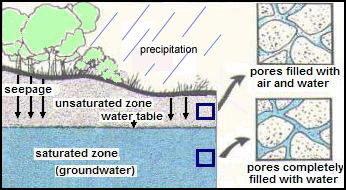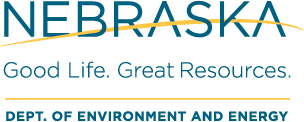Significance of the Vadose Zone
In Nebraska, most of the population relies on ground water for drinking. Unfortunately, nitrate concentrations in ground water in many parts of the state are rising. In addition, some pesticides, as well as uranium and other metals may be increasing across the state. While state and local agencies have conducted regular ground water monitoring, more work is needed to characterize the vadose (unsaturated) zone. The vadose zone is the area below the land surface and above the ground water table, where a mixture of air, water, and other chemical and biological microorganisms fills the spaces between rock and soil particles (Figure 1). The zone acts as the "skin" of the earth, regulating ground water recharge and chemical movement. Contaminants present in the vadose zone can eventually appear in the underlying aquifers.

Source: NYSDEC
Purpose of Vadose Zone Monitoring
To protect public health, the Environmental Protection Agency (EPA) regulates certain contaminants, including nitrate, through the National Primary Drinking Water Regulations (NPDWR). If contaminants are found in public water systems in excess of legally enforceable Maximum Contaminant Levels (MCLs), a utility must either treat the water or find an alternate supply. Thus, natural resources managers, city planners, treatment plant operators, regulators, researchers, and others have an interest in monitoring the vadose zone to anticipate if and when contaminants will reach the groundwater supply, and in what amount.

Coordination is still needed to monitor and model contaminants occurrence and movement across the vadose zone, which can be hundreds of feet thick. The Nebraska Vadose Zone program coordinates, standardizes, and shares past and ongoing studies of Nebraska's vadose zone on-line using GIS mapping. State and local entities may use this public database to make decisions and prepare for future changes in water quality. The quality-assessed data will contain chemical and hydraulic properties of the cores taken from the vadose zone. Future linkages to existing databases, such as the Quality-Assessed Agricultural Contaminant Database, will permit water managers and others to make correlations between occurrences of contaminants in groundwater to historic and present contaminants in the vadose zone.
Citation Instructions
When using Nebraska Vadose datasets in your work, please cite the data as:
Nebraska Water Center. (Year). Nebraska Vadose Database. University of Nebraska. Lincoln, NE, USA. https://nebraskavadose.unl.edu
Partners
Many partners contribute to the Nebraska Vadose Zone expansive public dataset. To learn more about sharing data, please see Data Submission.







